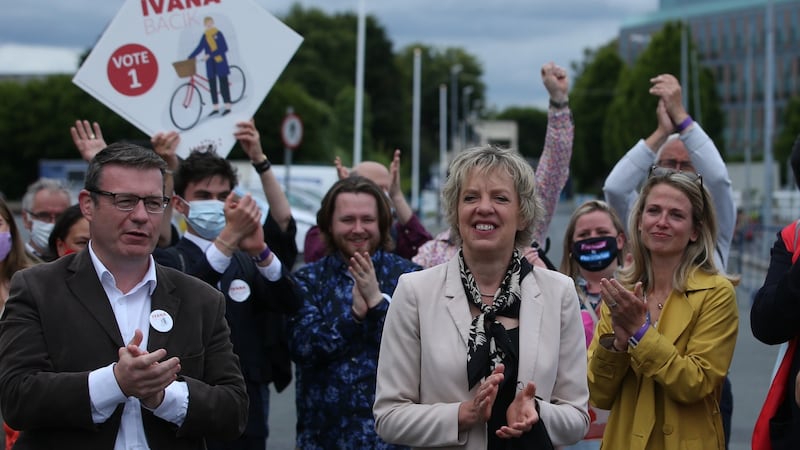There was a subtle but significant change in how the Labour Party approached the Dublin Bay South byelection that went largely unnoticed.
Sure, its new TD Ivana Bacik swept the boards in middle-class areas of a largely affluent constituency. But she also performed much more strongly in more traditionally working-class areas of the constituency, coming second to Lynn Boylan of Sinn Féin in Ringsend, Irishtown and the south inner city.
This was the result of a conscious decision by Labour Party strategists that they dubbed the “slow canvass”. In recent years pockets had grown up in the constituency that were the sole preserve of Sinn Féin.

In the past tumultuous decade, Labour’s relationship with its working-class base has been stretched to breaking point.
'We have done good things in the past where we changed Ireland, but we also have made mistakes'
The bruising experience in government between 2011 and 2016 led to bruising encounters on the doorsteps. It did not improve hugely between then and 2020, with other parties of the left deliberately excluding Labour from any voting pacts, questioning if the party was really on the left. A narrative grew up that it was more a liberal middle-class party, hence the success of Bacik. Some of its own people also became reluctant to canvass areas that were once welcoming but were now hostile.
“We acquired a bit of PTSD [post-traumatic stress disorder] over the last number of years,” says general secretary Billie Sparks. “Some people would have been reluctant to canvass in these areas.”
The party knew it had to re-engage with a working-class vote in order to recover its standing. Director of elections Duncan Smith and his team decided that a new approach was needed in this byelection.
“We used a different approach,” says Sparks. “We had some key elected representatives who were respected and trusted, former TDs such as Kevin Humphreys and Ruairí Quinn. They canvassed in small teams. It was very steady; they were slow canvasses.”
That meant a lot of time, a lot of engagement, no rushing from door to door and no hard sell. Most doors, people told them they were voting for Sinn Féin. The canvassers said that was okay but would you consider a No 2? Bacik herself arrived down each day to meet constituents, more frequently in the last week of the campaign. And it worked.
Keep it positive
The other thing that was noticeable about Bacik’s campaign was its lack of attack and negative campaigning, and her emphasis on solutions.
“Deliberately from the get-go, we were running a 100 per cent positive campaign and we were not going to get into negative campaigning,” says party leader Alan Kelly.
This was part of a wider strategy on positioning and definition of the party designed to distinguish itself from other parties to the left of centre. It is still in gestation.
“We are not a populist party that opposes everything,” says Kelly. “We backed property taxes, which is a demonstration of that. You can’t exist in the space of being a social democratic party if taxes like that don’t exist.
“We have done good things in the past where we changed Ireland, but we also have made mistakes.”
“We wear our hearts on our sleeves. The party is 109 year old. We still have a hefty organisation that we can mobilise. That distinguishes us from other parties.”
Sparks adds: “We are not afraid to say, ‘We are a party of the left who aspires to government’. We are the only Opposition party of the left which has experience of government.”

Smith says Labour needs to show it is not in the shadow of Sinn Féin.
“We have a different tradition and different values to Sinn Féin and others. We are not afraid to stand out from them. We are not in lockstep with them. It’s important to state the Labour brand did not damage Ivana Bacik during the campaign.”
So was this a flash in the pan? Could it all be attributed to Bacik’s huge standing? Or is it the spark to flame a Labour revival? Certainly, you can’t read too deeply into these things. Former Fine Gael TD Tom Hayes won a byelection in Tipperary South in 2001 that gave a huge boost to then leader Michael Noonan’s stock. But the party support collapsed in the general election the following year.
That said, there are signs Labour is on an upward curve after 10 years in the doldrums. Kelly has made an impact since becoming leader and has been dramatically more measured, mellow and collegiate in approach than his former shouty self.
“Alan is very clear and very unwavering on where he wants to bring the party. Having that clarity is good. People know what they can expect from him,” says Sparks.
She herself has only been in place since last August, and political director Conán Ó Broin is also new.
‘Ideal candidate’
The victory has been a morale-booster for the party. “It has changed the narrative,” says Smith. When I saw the headlines last weekend saying a Labour win, I knew there will be people who can look at our party again and believe in it.”
“It has made a big difference. We will grow back. We will not get there by default. We need to do the hard work and earn the respect of people.”
Sparks sees other signs on the organisational side: “The membership has risen by 20-25 per cent in the past year. We have consciously made an effort to be more attractive to women and younger people. Like other parties our membership is two-thirds male. In March we ran a ‘Sign up a sister’ campaign and that attracted over 100 new women members.”
David Farrell, professor of politics at UCD, says that the appeal of Bacik can’t be underestimated. “She was such an attractive candidate, a well-considered public intellectual, well-established on social and justice issues.
“It reminds you of 1973, when the party attracted some very impressive heavyweight intellectuals.
“They were lucky they had an ideal candidate. Whether that says much about the party’s future remains to be seen.”
Farrell makes a salient point that the space in which they are fishing for votes is very crowded. “The centre-left has the Greens, and Social Democrats, Sinn Féin somewhat, with Fianna Fáil maybe coming in from the other direction.
“There are always risks for every party in occupying similar spaces. The Social Democrats have had the spring in their step that Labour has lost, and not regained, since the ‘Gilmore gale’ of 2011.”
In the long term, Farrell says both parties cannot survive separately. “There has to be a reckoning between the Labour Party and the Social Democrats, which were formed partly as a result of a split.”
Sparks makes this observation. “The differences [between the parties] are personality more than policy.”
The party’s next big set-piece is its conference in November, where Kelly will set out his vision for the party and for the country. The conference may also decide if the party will go into government, and, if so, what its red lines will be.
Smith says the next opinion polls will be interesting. If they show an uplift, the party might then claim it has risen above the other small parties, and it presents a feasible alternative opposition to Sinn Féin. That will be a big claim, given that Sinn Féin currently has five times its Dáil strength.
The next electoral tests will be the directly elected mayor of Limerick and the local and European elections in 2024.
“We have 12-15 target constituencies and we are putting our energy into those,” says Sparks.
If it is to make gains, Labour needs to win more council seats in Cork, Limerick, Waterford, Galway and the capital plus traditionally strong counties such as Kildare, Wicklow and Westmeath. In the next general election, it will need some of the following to break through: Angela Feeney (Kildare North); Mark Wall (Kildare South); Ciarán Ahern (Dublin South West); Rebecca Moynihan (Dublin South Central); John Maher (Cork North Central); and Marie Sherlock (Dublin Central).
“The weight and history of the Labour Party lies heavily on our shoulders,” says Kelly. “We are determined to bring it back to where it was before.”







